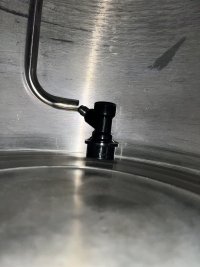Just did my first brew on my new 10.5 Anvil last night with my kid and it was a great experience. Of course since it was my first, I had to take the time to properly clean the whole system before even adding the water so it took a bit longer. I only have 120v and it would be quite an undertaking to get 240V set up in my house since I would have to add an entire sub electrical box so not going to do this anytime soon. Another problem I had was I did not have a hydrometer, Amazon was supposed to deliver it last night but they pushed this back a day so I didn't get a chance to do any readings. The recipe was a simple Blonde American ale with 10 lb of pale ale 2 row and 4 oz of honey malt. And using some 60/15/0 boil time additions American hops to get roughly 20 IBU. I should have taken the pre boil wart and saved some in the fidge as well as the post boil so I could test this today with a hydrometer, but did not think of this yesterday.
Mash was roughly 4.5 gallons of strike at 156 which put me at 153 for the mash in and it then, within like 10 min quickly stabilized at 152 and it pretty much kept it there for the entire hour at 70% power with the recirc pump going. At first I still had it at 100% and it would overshoot the temp to 154ish before again stabilizing at 152, so the decrease in power kept it perfectly at 152 for the remainder of the mash cycle. I used the malt pipe this time but I did get the brew in bag option so I will try this next time to see if I like it better. I then mashed out at 170F for 10 min which took the system like 15 min? to get there from 152, then held it there for 10 min with recirc still on. Then I sparged with 2 gallons of 170ish water for a final volume of about 6.2 gallons. Mash overall was great, set it and forget it if you remember to turn the power down to roughly 70% at 120V.
Then I se the thing to boil while sparging and it took about 45-50 min to get there. I did not mind this though since it allowed me to dump the grains, and clean the mash pipe in the mean time. I boiled this for 90 min with the hop additions at 60/15/0 min.
Cooling down after boil using the included wart chiller was about 15-20 min to take it down to 68F using my water which is at 55F or so. Honestly I think the time was reasonable but could probably get better using copper chiller vs the SS chiller, but really whats to complain about a 20 min or so chill time?
Drained this into my 6.5 gal carboy using the pump, pitched the safale -05 yeast dry and 12 hours later its taking off already.
Cleaning was not bad either, just fill the thing up with hot water and a few scoops of PBW and let the thing recirculate while I cleaned it with a sponge. Then rinsed it a few times and its all good to go for next time. total cleaning time was roughly 30 min? But that accounts for filling the thing up with the hot water too. Next time I will keep some of the hot water coming from the chiller in a large pot so I will use this hot water to clean it with. A thought that came to me after everything was done.
All in all it was a great experience brewing with the foundry 10.5. It was nice to spend some time with the kid which is usually down in the basement playing his vidja games. We shared some barley pops along the way and he genuinely showed an interest in the process. Hoping this continues since he likes his crafty beers and I hope this first batch showcases how great fresh homebrew beer can be.



































![Craft A Brew - Safale S-04 Dry Yeast - Fermentis - English Ale Dry Yeast - For English and American Ales and Hard Apple Ciders - Ingredients for Home Brewing - Beer Making Supplies - [1 Pack]](https://m.media-amazon.com/images/I/41fVGNh6JfL._SL500_.jpg)
























